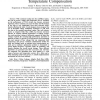Free Online Productivity Tools
i2Speak
i2Symbol
i2OCR
iTex2Img
iWeb2Print
iWeb2Shot
i2Type
iPdf2Split
iPdf2Merge
i2Bopomofo
i2Arabic
i2Style
i2Image
i2PDF
iLatex2Rtf
Sci2ools
103
click to vote
TVLSI
2008
2008
Body Bias Voltage Computations for Process and Temperature Compensation
With continued scaling into the sub-90nm regime, the role of process, voltage and temperature (PVT) variations on the performance of VLSI circuits has become extremely important. These variations can cause the delay and the leakage of the chip to vary significantly from their expected values, thereby affecting the yield. Circuit designers have proposed the use of threshold voltage modulation techniques to pull back the chip to the nominal operational region. One such scheme, known as Adaptive Body Bias (ABB), has become extremely effective in ensuring optimal performance or leakage savings. Our work provides a means to efficiently compute the body bias voltages required for ensuring high performance operation in gigascale systems. We provide a CAD perspective for determining the exact amount of bias voltages that can compensate both temperature and process variations. Mathematical models for delay and leakage based on minimal tester measurements are built, and a nonlinear optimization ...
Related Content
| Added | 16 Dec 2010 |
| Updated | 16 Dec 2010 |
| Type | Journal |
| Year | 2008 |
| Where | TVLSI |
| Authors | Sanjay V. Kumar, Chris H. Kim, Sachin S. Sapatnekar |
Comments (0)

